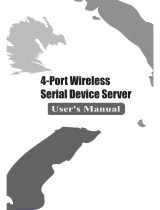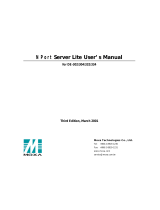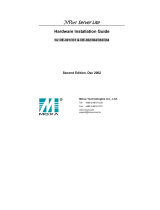
Table of Contents
1. Introduction ...................................................................................................................................... 1-1
Overview ........................................................................................................................................... 1-2
Package Checklist ............................................................................................................................... 1-2
NPort 6610/6650 ......................................................................................................................... 1-2
NPort 6150, NPort 6250, and NPort 6450 ....................................................................................... 1-3
Product Features ................................................................................................................................ 1-4
Product Selection Chart ....................................................................................................................... 1-4
2. Getting Started.................................................................................................................................. 2-1
Panel Layout ...................................................................................................................................... 2-2
NPort 6150/6250 ......................................................................................................................... 2-2
NPort 6450 ................................................................................................................................. 2-2
NPort 6610/6650 ......................................................................................................................... 2-3
Panel, DIN-Rail, and Rack-Mounting ...................................................................................................... 2-4
Connecting the Hardware..................................................................................................................... 2-5
Wiring Requirements ................................................................................................................... 2-5
Connecting the NPort 6600 VDC’s Power ........................................................................................ 2-5
Grounding the NPort 6600 VDC ..................................................................................................... 2-6
Connecting to the Network ........................................................................................................... 2-6
Connecting to a Serial Device ....................................................................................................... 2-6
LED Indicators ............................................................................................................................ 2-6
Adjustable Pull High/Low Resistors for the RS-485 Port .................................................................... 2-7
3. Initial IP Address Configuration ........................................................................................................ 3-1
Static and Dynamic IP Addresses .......................................................................................................... 3-2
Factory Default IP Address ................................................................................................................... 3-2
Configuration Options .......................................................................................................................... 3-2
Device Search Utility .................................................................................................................... 3-2
Web Console ............................................................................................................................... 3-2
LCM Console/Front Panel (NPort 6610, 6650, and 6450 only)............................................................ 3-2
ARP ........................................................................................................................................... 3-3
Telnet Console ............................................................................................................................ 3-4
Serial Console ............................................................................................................................. 3-7
4. Introducing Serial Port Operation Modes .......................................................................................... 4-1
Overview ........................................................................................................................................... 4-2
Guide to NPort 6000 Modes .................................................................................................................. 4-2
Device-Control Applications .................................................................................................................. 4-3
Real COM and Secure Real COM Modes .......................................................................................... 4-3
Reverse Real COM Mode ............................................................................................................... 4-4
RFC2217 Mode ............................................................................................................................ 4-4
Socket Applications ............................................................................................................................. 4-5
TCP Server and Secure TCP Server Modes ...................................................................................... 4-5
TCP Client and Secure TCP Client Modes ......................................................................................... 4-5
UDP Mode .................................................................................................................................. 4-6
Pair Connection and Secure Pair Connection Modes ................................................................................. 4-6
Ethernet Modem Mode ......................................................................................................................... 4-7
Terminal Applications .......................................................................................................................... 4-7
Terminal ASCII Mode ................................................................................................................... 4-8
Terminal BIN Mode ...................................................................................................................... 4-8
SSH Mode .................................................................................................................................. 4-8
Reverse Terminal Applications .............................................................................................................. 4-8
Reverse Telnet ............................................................................................................................ 4-9
Reverse SSH ............................................................................................................................... 4-9
Printer Modes ..................................................................................................................................... 4-9
Dial In/Out Modes ............................................................................................................................. 4-10
Disabled Mode .................................................................................................................................. 4-10
5. Configuration with the Web Console ................................................................................................. 5-1
Using Your Web Browser ...................................................................................................................... 5-2
Browser Cookie Settings............................................................................................................... 5-2
Trusted Site Settings ................................................................................................................... 5-3
Opening the Web Console ............................................................................................................. 5-4
Web Console Navigation ...................................................................................................................... 5-5
Network Configuration ......................................................................................................................... 5-5
Basic Network Settings ................................................................................................................ 5-5
Advanced Network Settings .......................................................................................................... 5-8
Setting up the DDNS ................................................................................................................... 5-9
Configuring the Route Table........................................................................................................ 5-10
6. Module Settings ................................................................................................................................ 6-1
NM-TX01, NM-TX02, NM-FX01-M-SC, NM-FX01-S-SC, NM-FX02-M-SC, NM-FX02-S-SC ................................ 6-2
Using Ethernet Redundancy .......................................................................................................... 6-2


























